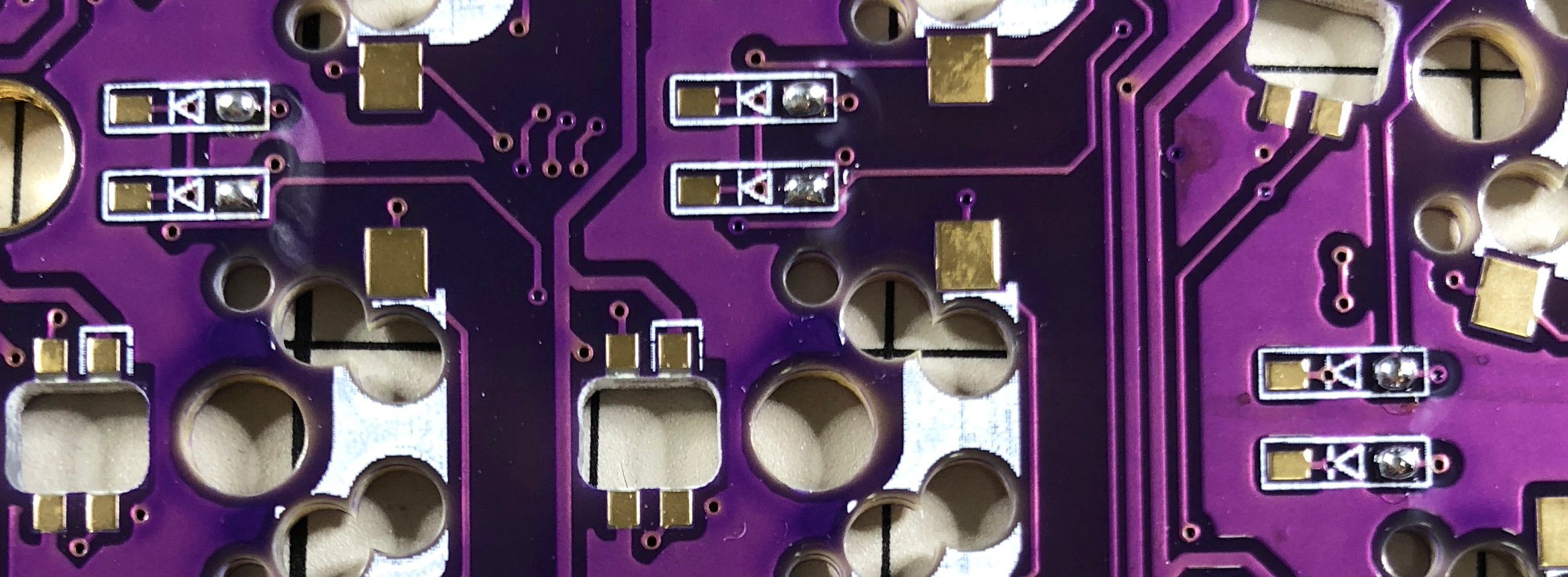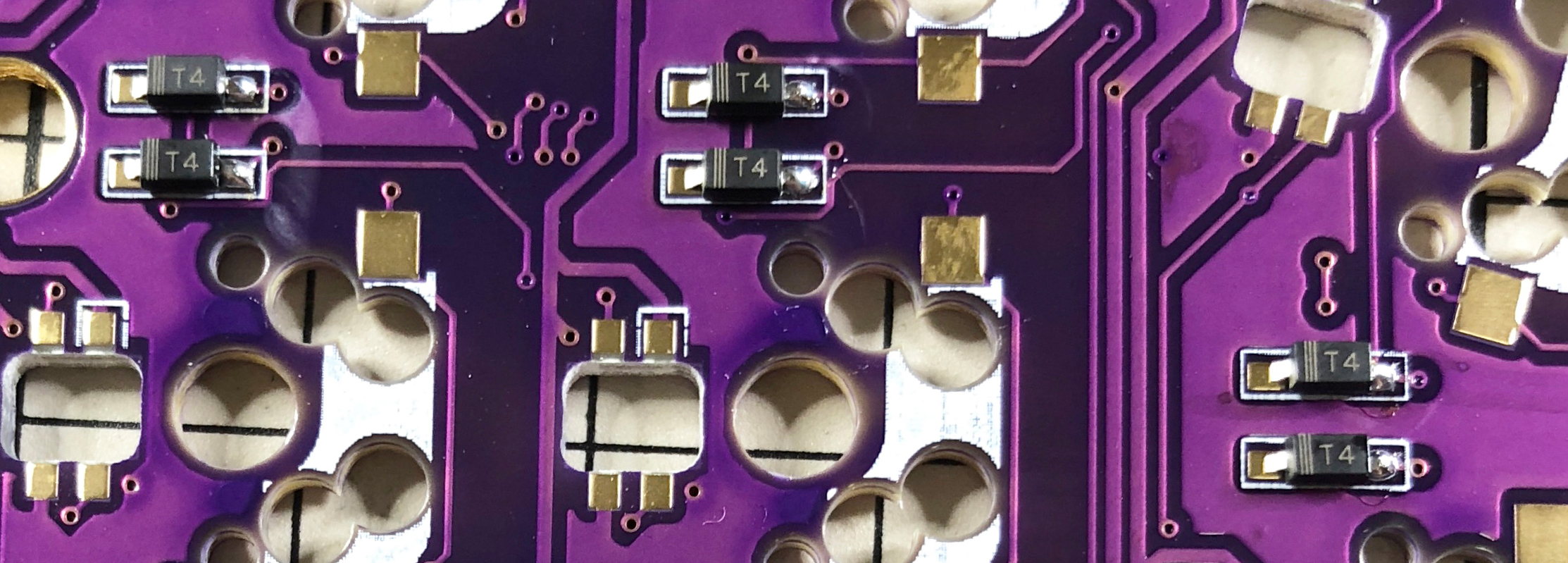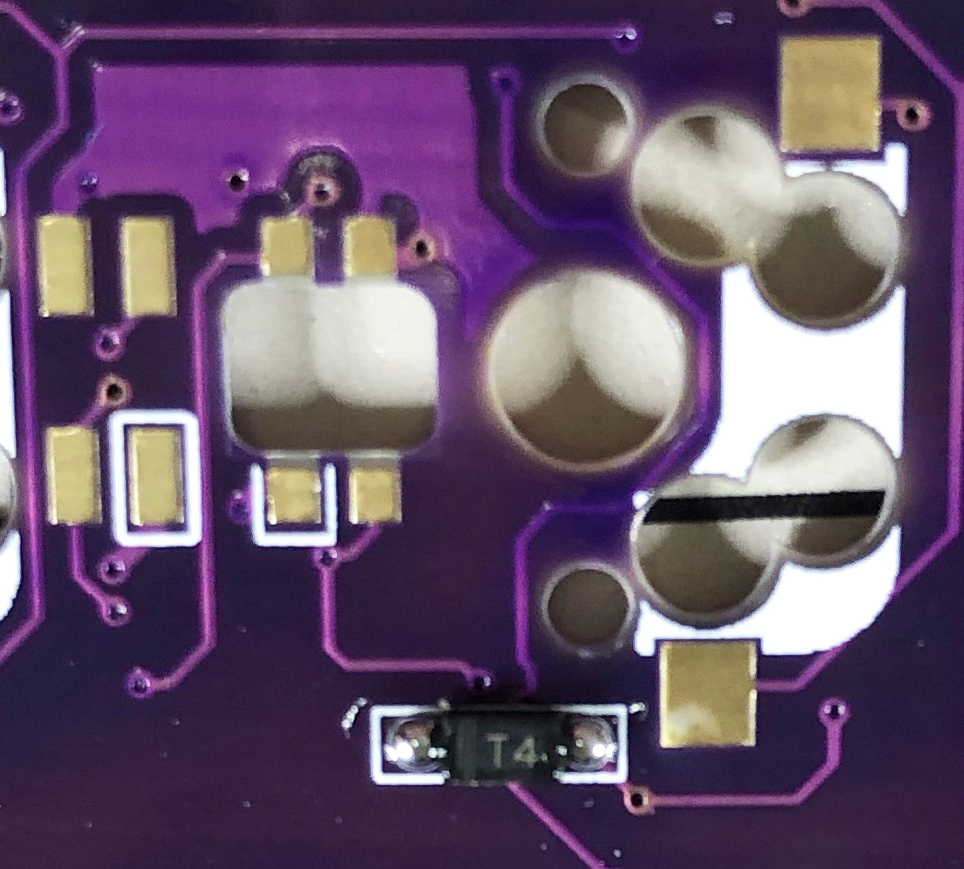2021-04-17 15:22:45 +02:00
|
|
|
# Build Guide
|
|
|
|
|
|
|
|
|
|
This is the build guide for Corne Cherry v3.
|
2021-05-15 11:20:11 +02:00
|
|
|
[Click here for the Corne Cherry v2 build guide](
|
2021-04-17 15:22:45 +02:00
|
|
|
https://github.com/foostan/crkbd/blob/master/corne-cherry/doc/v2/buildguide_en.md).
|
|
|
|
|
|
|
|
|
|
## Parts
|
|
|
|
|
|
|
|
|
|
### Required
|
|
|
|
|
|
2021-05-15 08:51:41 +02:00
|
|
|
| Name | Count | Remarks |
|
2021-04-17 15:22:45 +02:00
|
|
|
|:-|:-|:-|
|
|
|
|
|
| PCB | 1 set | |
|
|
|
|
|
| Top plate | 2 sheets | |
|
|
|
|
|
| Bottom plate | 2 sheets | |
|
2022-03-16 06:05:16 +01:00
|
|
|
| OLED cover | 2 sheets | |
|
|
|
|
|
| ProMicro | 2 | |
|
2021-04-17 15:22:45 +02:00
|
|
|
| TRRS jack | 2 | |
|
2022-03-16 06:05:16 +01:00
|
|
|
| Reset switch | 2 | |
|
2021-04-17 15:22:45 +02:00
|
|
|
| Diodes | 42 | Only SMD parts are supported |
|
|
|
|
|
| PCB sockets | 42 | Compatible with Kailh and Gateron |
|
|
|
|
|
| Key switches | 42 | Only compatible with CherryMX |
|
|
|
|
|
| Keycaps | 42 pcs | 1u 40 pcs, 1.5u 2 pcs |
|
|
|
|
|
| Spacer M2 7.5mm | 10 pieces | |
|
|
|
|
|
| Spacer M2 9mm | 4 pieces | |
|
|
|
|
|
| Screw M2 4mm | 28 screws | |
|
2022-03-16 06:05:16 +01:00
|
|
|
| Rubber feet | 8 pieces | |
|
2021-04-17 15:22:45 +02:00
|
|
|
| TRRS (4 poles) cable | 1 | TRS (3 poles) cable is also acceptable |
|
|
|
|
|
| Micro USB cable | 1 | |
|
|
|
|
|
|
2021-05-15 08:52:32 +02:00
|
|
|
### Optional
|
2021-04-17 15:22:45 +02:00
|
|
|
|
2021-05-15 08:51:41 +02:00
|
|
|
| Name | Count | Remarks |
|
2021-04-17 15:22:45 +02:00
|
|
|
|:-|:-|:-|
|
2022-03-16 06:05:16 +01:00
|
|
|
| OLED module | 2 | |
|
2021-04-17 15:22:45 +02:00
|
|
|
| Pin header for OLED module 4 series 1.5mm | 2 | |
|
|
|
|
|
| 4 pin sockets for OLED module 2.5mm | 2 | |
|
|
|
|
|
| SK6812MINI-E | 42 pieces | LEDs for Back light |
|
|
|
|
|
| WS2812B | 12 | LEDs for Undergrow |
|
|
|
|
|
|
2022-03-16 06:05:16 +01:00
|
|
|
## Firmware preparation
|
2021-04-17 15:22:45 +02:00
|
|
|
|
2022-03-16 06:05:16 +01:00
|
|
|
If you build the firmware yourself, it will take some time to set up the environment,
|
|
|
|
|
so it's best to start at the beginning.
|
|
|
|
|
It is recommended to flash ProMicro's prior to soldering.
|
2021-05-15 11:20:11 +02:00
|
|
|
For more information,
|
|
|
|
|
please see <https://github.com/foostan/crkbd/blob/master/doc/firmware_en.md>.
|
2021-04-17 15:22:45 +02:00
|
|
|
|
|
|
|
|
## Verification
|
|
|
|
|
|
|
|
|
|
The PCB for Corne Cherry v3 is as follows.
|
|
|
|
|
Make sure it is the same as your PCB.
|
|
|
|
|
|
|
|
|
|

|
|
|
|
|
|
|
|
|
|

|
|
|
|
|
|
|
|
|
|
The PCB comes with a frame for manufacturing reasons.
|
|
|
|
|
You can fold it by hand to remove it, but if it is difficult,
|
2021-05-15 11:20:11 +02:00
|
|
|
make a cut in the joint \* with a cutter or similar,
|
|
|
|
|
to make it easier to remove.
|
2021-04-17 15:22:45 +02:00
|
|
|
In addition, the joint can be cleaned with a file.
|
|
|
|
|
|
|
|
|
|
\* *Joint part: There are a total of 8 parts,
|
|
|
|
|
which are marked in red in the image below.*
|
|
|
|
|
|
|
|
|
|

|
|
|
|
|
|
|
|
|
|
## Assembly
|
|
|
|
|
|
2021-05-15 08:52:32 +02:00
|
|
|
### Diodes
|
2021-04-17 15:22:45 +02:00
|
|
|
|
|
|
|
|
Solder diodes for SMD components.
|
|
|
|
|
Since SMD parts are very small,
|
|
|
|
|
it is convenient to have tweezers and counter-acting tweezers.
|
|
|
|
|
|
|
|
|
|
**The diode has a fixed mounting direction**,
|
2021-05-15 11:20:11 +02:00
|
|
|
so solder it so that the "|" mark on the part faces the "|" on the diode mark "|◁".
|
2021-04-17 15:22:45 +02:00
|
|
|
In addition, Corne's PCB has all the same diode mounting orientations.
|
|
|
|
|
|
|
|
|
|

|
|
|
|
|
|
|
|
|
|
<details>
|
|
|
|
|
<summary>TIPS: Tips for installing SMD parts</summary>
|
|
|
|
|
|
|
|
|
|
The trick is to attach the SMD parts, but first, as a spare solder,
|
|
|
|
|
put the solder on only one side of the pad.
|
|
|
|
|
|
|
|
|
|

|
|
|
|
|
|
|
|
|
|
Next, solder one leg of the diode so that the spare solder melts.
|
2021-05-15 11:20:11 +02:00
|
|
|
At this time,
|
|
|
|
|
it is recommended to use [reverse-action tweezers](https://www.alimed.com/_resources/cache/images/product/70895A_850x480-pad.jpg),
|
|
|
|
|
so that you can hold the SMD part firmly without applying force,
|
|
|
|
|
and concentrate on alignment and soldering instead.
|
|
|
|
|
Also, if the soldering iron is too hot or the solder is touched too long,
|
|
|
|
|
the flux contained in the solder may evaporate and form an undesirable pile solder,
|
|
|
|
|
but since it can be repaired later,
|
|
|
|
|
so at this point you should only care about attaching parts.
|
2021-04-17 15:22:45 +02:00
|
|
|
It's okay.
|
|
|
|
|
|
|
|
|
|

|
|
|
|
|
|
|
|
|
|
It is okay if the diode does not float when viewed from the side
|
|
|
|
|
when one foot is attached.
|
|
|
|
|
If it floats, press the diode with tweezers or your fingers
|
|
|
|
|
and reheat the soldered part with a soldering iron to clean it.
|
|
|
|
|
|
|
|
|
|

|
|
|
|
|
|
2021-05-15 11:20:11 +02:00
|
|
|
Then solder the other pin.
|
|
|
|
|
Be careful not to apply too much solder,
|
|
|
|
|
as a small amount is sufficient.
|
|
|
|
|
If you have applied too much,
|
|
|
|
|
you can remove it with a suction pump, blotting wire
|
2021-04-17 15:22:45 +02:00
|
|
|
or by scooping it with a soldering iron.
|
|
|
|
|
|
|
|
|
|
If the amount of solder on the preliminary solder side is small,
|
2021-05-15 11:20:11 +02:00
|
|
|
additional soldering is performed, and if it is a heap,
|
2021-04-17 15:22:45 +02:00
|
|
|
apply flux from above and heat it to clean it.
|
|
|
|
|
|
|
|
|
|

|
|
|
|
|
|
|
|
|
|
</details>
|
|
|
|
|
|
|
|
|
|
The diode is completed by soldering 42 pieces in total on the left and right.
|
|
|
|
|
|
|
|
|
|

|
|
|
|
|
|
|
|
|
|
### LED (optional)
|
|
|
|
|
|
|
|
|
|
Solder the SK6812MINI-E and WS2812B.
|
|
|
|
|
|
|
|
|
|
First, check the state after installation.
|
|
|
|
|
|
|
|
|
|

|
|
|
|
|
|
|
|
|
|
All soldering is done from the back side, but the SK6812MINI-E is for Backlight
|
|
|
|
|
(the front side is shining) and the WS2812B is for Undergrow (the back side is shining).
|
|
|
|
|

|
|
|
|
|
|
|
|
|
|
#### WS2812B (Undergrow)
|
|
|
|
|
|
|
|
|
|
First, solder the WS2812B.
|
|
|
|
|
|
|
|
|
|
Solder with the corners of the recesses on the WS2812B
|
|
|
|
|
and the corner marks on the PCB aligned as shown below.
|
|
|
|
|
**TIPS: As I introduced in Tips for Installing SMD Parts**,
|
|
|
|
|
I think that you can attach it well with spare solder.
|
|
|
|
|
|
|
|
|
|
In addition, his PCB of Corne has the same mounting orientation of his WS2812B.
|
|
|
|
|
|
|
|
|
|

|
|
|
|
|
|
2021-08-14 15:12:57 +02:00
|
|
|
He soldered a total of 12 pieces on the left and right, and he completed the WS2812B.
|
2021-04-17 15:22:45 +02:00
|
|
|
|
|
|
|
|

|
|
|
|
|
|
|
|
|
|
#### SK6812MINI-E (Backlight)
|
|
|
|
|
|
|
|
|
|
Then solder the SK6812MINI-E.
|
|
|
|
|
|
|
|
|
|
Solder the SK6812MINI-E with the missing corners aligned with the PCB corners
|
|
|
|
|
as shown below.
|
|
|
|
|
**TIPS: As I introduced in Tips for Installing SMD Parts**,
|
|
|
|
|
I think that you can attach it well with spare solder.
|
|
|
|
|
It is harder to break than the SK6812MINI,
|
|
|
|
|
but it may be damaged if it is directly exposed to the heat of a soldering iron.
|
|
|
|
|
If the temperature is about 320°C
|
|
|
|
|
with a soldering iron with a temperature control function,
|
|
|
|
|
it seems that there is no problem even if four legs are soldered continuously.
|
|
|
|
|
|
|
|
|
|
All Corne PCBs have the same mounting orientation for the SK6812MINI-E.
|
|
|
|
|
|
|
|
|
|

|
|
|
|
|
|
|
|
|
|
SK6812MINI-E is completed by soldering a total of 42 pieces on the left and right.
|
|
|
|
|
|
|
|
|
|

|
|
|
|
|
|
|
|
|
|
### TRRS jack, reset switch, pin socket for OLED
|
|
|
|
|
|
|
|
|
|
Solder the TRRS jack, reset switch (tact switch),
|
|
|
|
|
and OLED pin socket as shown in the picture below.
|
|
|
|
|
|
|
|
|
|

|
|
|
|
|
|
|
|
|
|
Since it is a part that easily slips off,
|
|
|
|
|
you can solder it while holding the part by hand,
|
|
|
|
|
or fix it with masking tape and then solder it.
|
|
|
|
|
|
|
|
|
|
### ProMicro
|
|
|
|
|
|
2022-03-16 06:05:16 +01:00
|
|
|
Solder headers to PCB. Then solder ProMicro to headers, with components facing PCB
|
2021-04-17 15:22:45 +02:00
|
|
|
|
|
|
|
|

|
|
|
|
|
|
2021-05-15 11:20:11 +02:00
|
|
|
If you use spring-loaded pin headers (e.g. Conthrough),
|
|
|
|
|
you do not need to solder the back side.
|
|
|
|
|
Please refer to the [Helix Build Guide](
|
2021-04-17 15:22:45 +02:00
|
|
|
https://github.com/MakotoKurauchi/helix/blob/master/Doc/buildguide_en.md#pro-micro)
|
2021-05-15 11:20:11 +02:00
|
|
|
for details on how to use spring-loaded pin headers.
|
2021-04-17 15:22:45 +02:00
|
|
|
|
|
|
|
|

|
|
|
|
|
|
|
|
|
|
### OLED module
|
|
|
|
|
|
|
|
|
|
Insert the pin header into the pin socket for OLED first,
|
|
|
|
|
and then solder the pin header and OLED module.
|
|
|
|
|
At this time, the OLED module is easy to float,
|
|
|
|
|
so be careful not to float it while pressing it with your finger.
|
|
|
|
|
|
|
|
|
|

|
|
|
|
|
|
|
|
|
|
### Operation check
|
|
|
|
|
|
|
|
|
|
We recommend that you check the operation when the ProMicro and OLED module are attached.
|
|
|
|
|
If you do it at the very end, it will be difficult to isolate the problem.
|
|
|
|
|
|
2021-05-15 11:20:11 +02:00
|
|
|
To check the operation,
|
|
|
|
|
connect the left hand side to the PC with MicroUSB,
|
2021-04-17 15:22:45 +02:00
|
|
|
and connect the left hand side and the right hand side with the TRRS cable.
|
|
|
|
|
Since there may be defects such as jacks,
|
2021-05-15 11:20:11 +02:00
|
|
|
be sure to connect the left and right instead of one by one
|
|
|
|
|
before checking the operation.
|
2021-04-17 15:22:45 +02:00
|
|
|
If it is done correctly so far,
|
|
|
|
|
if you short the pad to attach the PCB socket with tweezers etc.,
|
|
|
|
|
the key pressed on the OLED module will be displayed.
|
|
|
|
|
|
|
|
|
|
### PCB socket
|
|
|
|
|
|
|
|
|
|
Solder the PCB socket according to the mark as shown below.
|
|
|
|
|
All the PCB sockets are listed below,
|
|
|
|
|
but I'm not really into it,
|
|
|
|
|
so attach them one by one.
|
|
|
|
|
**TIPS: As I introduced in Tips for Installing SMD Parts**,
|
|
|
|
|
I think that you can attach it well with spare solder.
|
|
|
|
|
|
|
|
|
|

|
|
|
|
|
|
|
|
|
|
The PCB socket is completed by soldering a total of 42 left and right.
|
|
|
|
|
|
|
|
|
|

|
|
|
|
|
|
|
|
|
|
### OLED protective plate
|
|
|
|
|
|
2021-05-15 11:20:11 +02:00
|
|
|
Attach the OLED protective plate with M2 9mm spacers and M2 screws.
|
2021-04-17 15:22:45 +02:00
|
|
|
|
|
|
|
|

|
|
|
|
|

|
|
|
|
|
|
|
|
|
|
### Plates, switches
|
|
|
|
|
|
|
|
|
|
After attaching the key switch to the top plate,
|
|
|
|
|
fit the key switch into the socket.
|
|
|
|
|
If you attach all the key switches to the top plate first,
|
|
|
|
|
it will be more difficult to fit them in the socket,
|
|
|
|
|
so it is easier to attach only the end key switches first.
|
|
|
|
|

|
|
|
|
|
|
|
|
|
|
Install the M2 7.5mm spacer and M2 screws on the top plate.
|
|
|
|
|
|
|
|
|
|

|
|
|
|
|
|
|
|
|
|
It is easy to screw the spacer after inserting it into the hole from the back side.
|
|
|
|
|
|
|
|
|
|

|
|
|
|
|
|
|
|
|
|
Attach the bottom plate with M2 screws.
|
|
|
|
|
|
|
|
|
|

|
|
|
|
|
|
|
|
|
|
Install the cushion rubber in the following positions.
|
|
|
|
|
|
|
|
|
|

|
|
|
|
|
|
|
|
|
|
That's it.
|
|
|
|
|
|
|
|
|
|

|